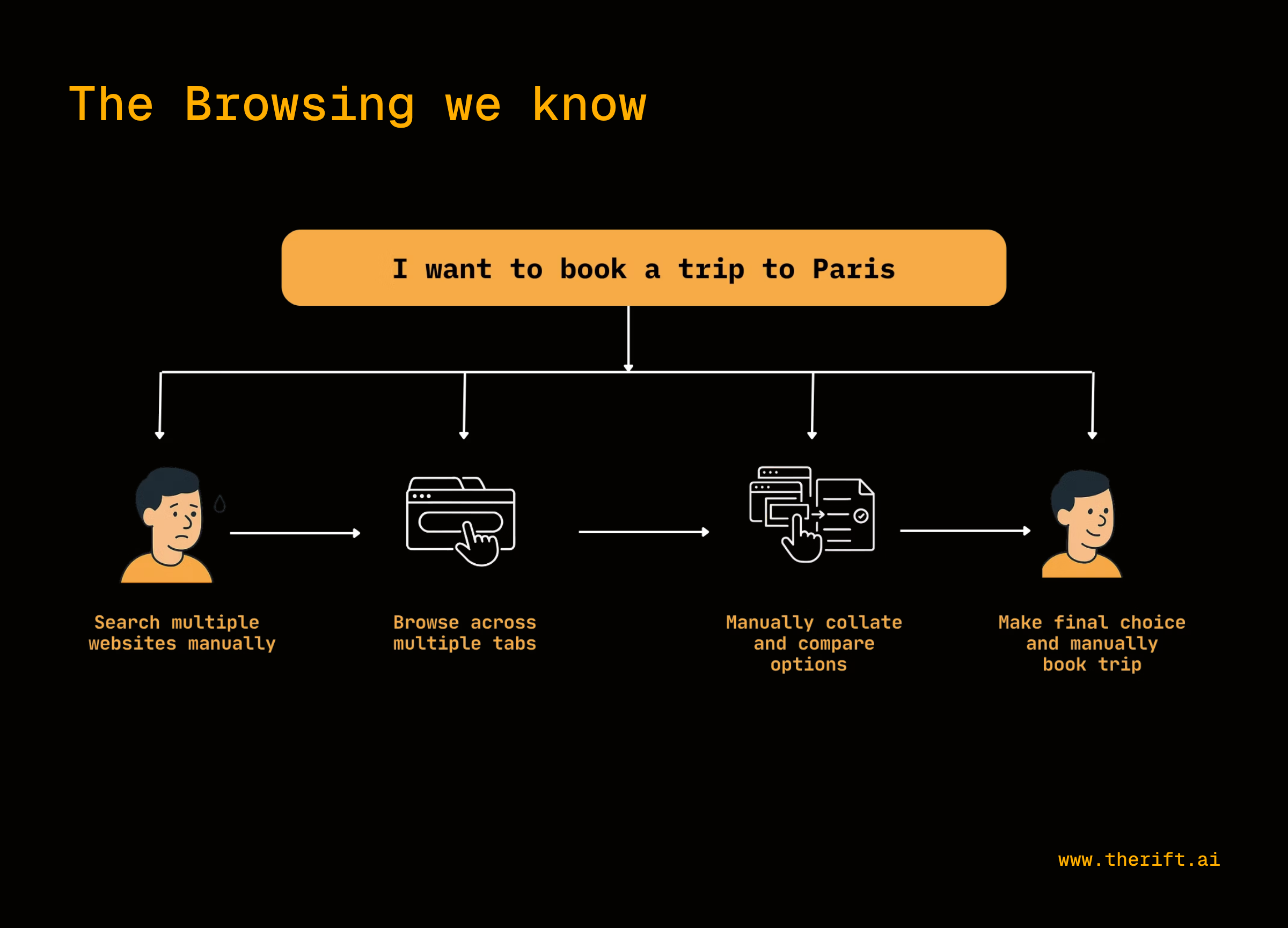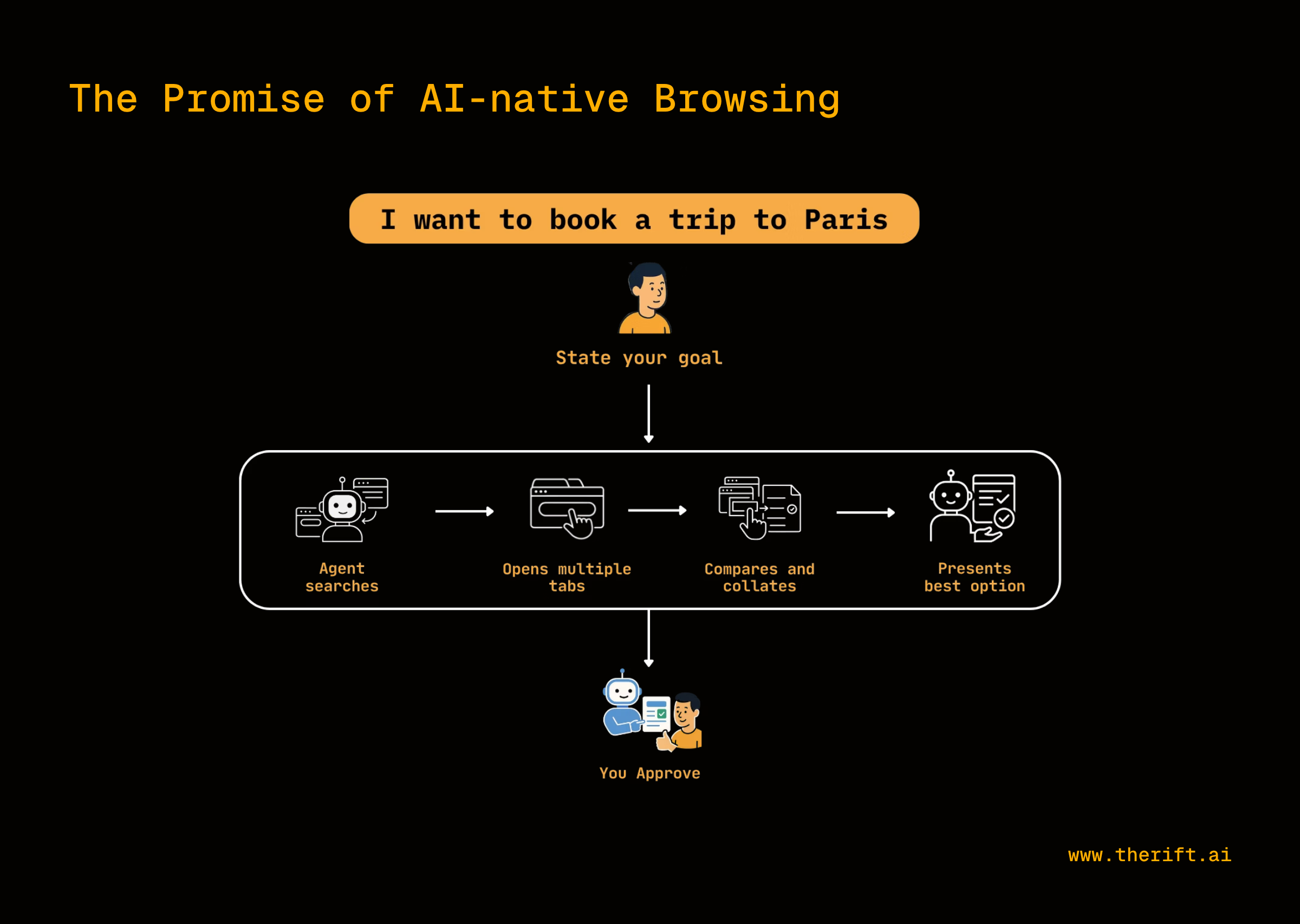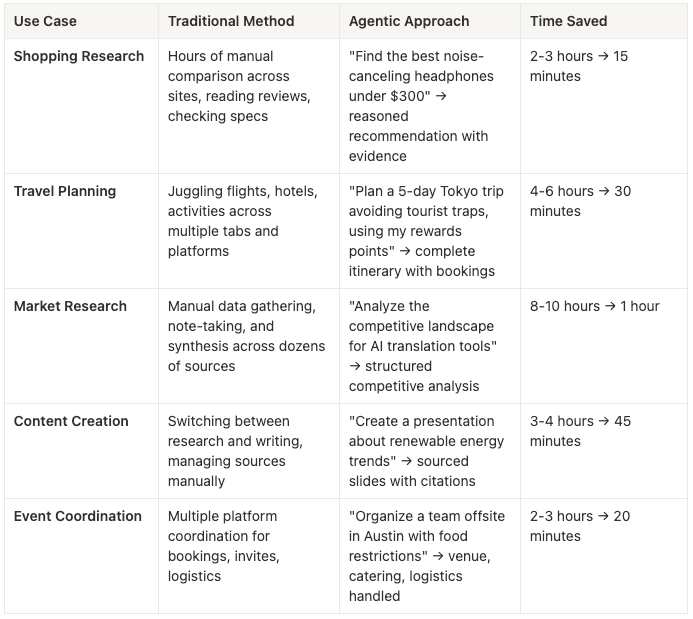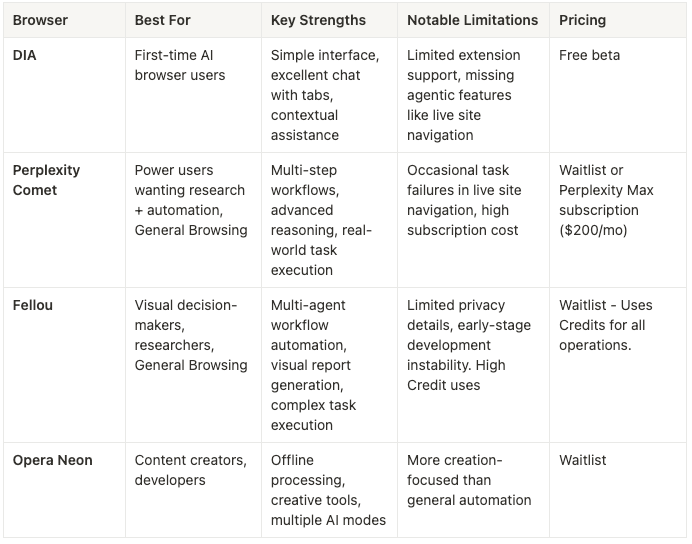
What is AI-native or Agentic Browsing?


Foundational





Picture this: You have 15 tabs open. You're researching competitors, comparing products, taking notes, drafting emails, and trying to synthesize everything into a coherent strategy. Your browser has become a digital version of a messy desk—scattered documents everywhere, but no assistant to help organize or act on what you've found.
What if your browser could be more like a skilled research assistant? One that not only finds information but understands your goals, connects the dots across multiple sources, and can actually take actions on your behalf?
This is the promise of agentic browsing—transforming your browser from a passive document viewer into an intelligent collaborator that can see, understand, and act across the entire web.
What You'll Learn in This Guide
- What agentic browsers are and why they're revolutionary (not just evolutionary)
- How they work under the hood and what makes them different
- Real-world applications that will change how you work online
- Current options and which one fits your needs
- Practical tips for getting started and avoiding pitfalls
- Privacy considerations and honest limitations
- What's coming next and how to prepare
Subscribe now to unlock the full article and gain unlimited access to all premium content.
SubscribePicture this: You have 15 tabs open. You're researching competitors, comparing products, taking notes, drafting emails, and trying to synthesize everything into a coherent strategy. Your browser has become a digital version of a messy desk—scattered documents everywhere, but no assistant to help organize or act on what you've found.
What if your browser could be more like a skilled research assistant? One that not only finds information but understands your goals, connects the dots across multiple sources, and can actually take actions on your behalf?
This is the promise of agentic browsing—transforming your browser from a passive document viewer into an intelligent collaborator that can see, understand, and act across the entire web.
What You'll Learn in This Guide
- What agentic browsers are and why they're revolutionary (not just evolutionary)
- How they work under the hood and what makes them different
- Real-world applications that will change how you work online
- Current options and which one fits your needs
- Practical tips for getting started and avoiding pitfalls
- Privacy considerations and honest limitations
- What's coming next and how to prepare
What Makes Agentic Browsing Revolutionary
The Traditional Web Experience: A Series of Manual Tasks
Currently, when you want to accomplish something online, you become a digital choreographer:
- You search for information across multiple sites
- You compare options, read reviews, check specifications
- You copy and paste data, take notes, remember context
- You fill forms, navigate checkout processes, coordinate between platforms
- You synthesize everything into decisions and actions

The Agentic Revolution: From Choreographer to Director
Agentic browsing flips this dynamic. Instead of choreographing every step, you become a director giving high-level instructions:
You say: "I want to book a trip to Paris from NYC, leaving on Sept 1st and returning on 15th. Find me the cheapest flight and hotel options. I would like a hotel in a safe neighborhood in Paris, close to cafes and restaurants."
The browser:
- Searches multiple travel websites.
- Reads neighborhood reviews
- Compares Flight options and prices from different airlines.
- Considers hotel options in researched neighborhoods
- Presents a reasoned recommendation with supporting evidence.

The key difference: The browser doesn't just find information—it understands your intent, makes decisions, and can take actions across websites autonomously.
Core Capabilities That Change Everything
Based on real implementations in DIA, Perplexity Comet, and Fellou, here are some capabilities that consistently define the agentic browsing experience:
1. Multi-Tab Context Synthesis
What it actually does: The AI can "see" and understand content across all your open browser tabs simultaneously, then combine that information into coherent insights.
Real example from DIA: "Compare these mics for me, read the reviews and list known issues that users have encountered. Suggest the best option, i need for it to arrive fast”
Why this matters: Instead of manually copying information between tabs and trying to remember details, you get instant synthesis of everything you're researching.
2. Contextual Conversation Across Sessions
What it actually does: The browser remembers what you were working on and maintains conversation context even when you switch between different websites and tasks.
Real example from Comet: "Find the last creatine i bought on amazon and buy a new one"
Why this matters: You can have ongoing "research conversations" without constantly re-explaining your goals or starting over.
3. Automated Workflow Execution
What it actually does: The browser can perform complete sequences of actions across websites - like filling forms, making purchases, or booking appointments - based on natural language instructions.
Real example from Fellou: "i want to cook shepherds pie with beef. Make me a grocery cart from the nearest store that delivers the quickest and give me a solid recipe to impress my friends.
Why this matters: Complex online tasks that typically take 30 minutes of clicking and form-filling can be completed with a single instruction.
Real-World Applications: Where Agentic Browsing Shines

Current Market Leaders: Your Options in 2025

What's Coming Soon
- OpenAI Browser: Deep ChatGPT integration. No Additional features announced yet.
- Google Chrome AI: Gemini-powered AI features
- Microsoft Edge Copilot Mode: Experimental agentic features with natural language task automation
Honest Talk: Current Limitations & Real-World Issues
While agentic browsers promise a revolutionary experience, they face several significant challenges today:
- Limited Reliability: While its still early, the current AI browsers can still be buggy and fail at certain complex tasks.
- Performance Issues: Slower speeds, occasional crashes, and laggy animations, especially on older hardware
- Interface Challenges: Agents struggle with human-designed web interfaces, missing hidden elements and interactive components
- Cost Barriers: High subscription prices and limited availability restrict widespread adoption
- Data Processing: Requires processing vast amounts of personal browsing data. The privacy landscape is not fully understood yet.
- Unclear Privacy Policies: Many platforms don't adequately explain how your data is processed, stored, or shared
Key Takeaways
The revolution is real but early-stage. Agentic browsers represent a genuine shift toward outcome-based computing, though current implementations face significant limitations. Early adopters gain productivity advantages while helping shape the technology's evolution. Start experimenting now with realistic expectations about current capabilities, but prioritize privacy by understanding data processing before committing to any platform.
The question isn't whether this transformation will happen, but how quickly you want to start benefiting from it—while remaining mindful of the genuine limitations and privacy considerations that exist today.
Picture this: You have 15 tabs open. You're researching competitors, comparing products, taking notes, drafting emails, and trying to synthesize everything into a coherent strategy. Your browser has become a digital version of a messy desk—scattered documents everywhere, but no assistant to help organize or act on what you've found.
What if your browser could be more like a skilled research assistant? One that not only finds information but understands your goals, connects the dots across multiple sources, and can actually take actions on your behalf?
This is the promise of agentic browsing—transforming your browser from a passive document viewer into an intelligent collaborator that can see, understand, and act across the entire web.
What You'll Learn in This Guide
- What agentic browsers are and why they're revolutionary (not just evolutionary)
- How they work under the hood and what makes them different
- Real-world applications that will change how you work online
- Current options and which one fits your needs
- Practical tips for getting started and avoiding pitfalls
- Privacy considerations and honest limitations
- What's coming next and how to prepare
What Makes Agentic Browsing Revolutionary
The Traditional Web Experience: A Series of Manual Tasks
Currently, when you want to accomplish something online, you become a digital choreographer:
- You search for information across multiple sites
- You compare options, read reviews, check specifications
- You copy and paste data, take notes, remember context
- You fill forms, navigate checkout processes, coordinate between platforms
- You synthesize everything into decisions and actions

The Agentic Revolution: From Choreographer to Director
Agentic browsing flips this dynamic. Instead of choreographing every step, you become a director giving high-level instructions:
You say: "I want to book a trip to Paris from NYC, leaving on Sept 1st and returning on 15th. Find me the cheapest flight and hotel options. I would like a hotel in a safe neighborhood in Paris, close to cafes and restaurants."
The browser:
- Searches multiple travel websites.
- Reads neighborhood reviews
- Compares Flight options and prices from different airlines.
- Considers hotel options in researched neighborhoods
- Presents a reasoned recommendation with supporting evidence.

The key difference: The browser doesn't just find information—it understands your intent, makes decisions, and can take actions across websites autonomously.
Core Capabilities That Change Everything
Based on real implementations in DIA, Perplexity Comet, and Fellou, here are some capabilities that consistently define the agentic browsing experience:
1. Multi-Tab Context Synthesis
What it actually does: The AI can "see" and understand content across all your open browser tabs simultaneously, then combine that information into coherent insights.
Real example from DIA: "Compare these mics for me, read the reviews and list known issues that users have encountered. Suggest the best option, i need for it to arrive fast”
Why this matters: Instead of manually copying information between tabs and trying to remember details, you get instant synthesis of everything you're researching.
2. Contextual Conversation Across Sessions
What it actually does: The browser remembers what you were working on and maintains conversation context even when you switch between different websites and tasks.
Real example from Comet: "Find the last creatine i bought on amazon and buy a new one"
Why this matters: You can have ongoing "research conversations" without constantly re-explaining your goals or starting over.
3. Automated Workflow Execution
What it actually does: The browser can perform complete sequences of actions across websites - like filling forms, making purchases, or booking appointments - based on natural language instructions.
Real example from Fellou: "i want to cook shepherds pie with beef. Make me a grocery cart from the nearest store that delivers the quickest and give me a solid recipe to impress my friends.
Why this matters: Complex online tasks that typically take 30 minutes of clicking and form-filling can be completed with a single instruction.
Real-World Applications: Where Agentic Browsing Shines

Current Market Leaders: Your Options in 2025

What's Coming Soon
- OpenAI Browser: Deep ChatGPT integration. No Additional features announced yet.
- Google Chrome AI: Gemini-powered AI features
- Microsoft Edge Copilot Mode: Experimental agentic features with natural language task automation
Honest Talk: Current Limitations & Real-World Issues
While agentic browsers promise a revolutionary experience, they face several significant challenges today:
- Limited Reliability: While its still early, the current AI browsers can still be buggy and fail at certain complex tasks.
- Performance Issues: Slower speeds, occasional crashes, and laggy animations, especially on older hardware
- Interface Challenges: Agents struggle with human-designed web interfaces, missing hidden elements and interactive components
- Cost Barriers: High subscription prices and limited availability restrict widespread adoption
- Data Processing: Requires processing vast amounts of personal browsing data. The privacy landscape is not fully understood yet.
- Unclear Privacy Policies: Many platforms don't adequately explain how your data is processed, stored, or shared
Key Takeaways
The revolution is real but early-stage. Agentic browsers represent a genuine shift toward outcome-based computing, though current implementations face significant limitations. Early adopters gain productivity advantages while helping shape the technology's evolution. Start experimenting now with realistic expectations about current capabilities, but prioritize privacy by understanding data processing before committing to any platform.
The question isn't whether this transformation will happen, but how quickly you want to start benefiting from it—while remaining mindful of the genuine limitations and privacy considerations that exist today.


.svg)